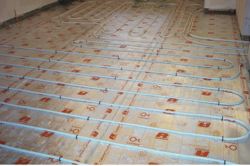Underfloor heating meets new Building Regulations

Wet underfloor heating systems enable condensing boilers to perform to their maximum energy-saving potential and are also well suited to renewable-energy sources such as ground-source heat pumps.
The characteristics of underfloor heating systems lend themselves to achieving compliance with the requirements of the forthcoming Building Regulations to reduce the carbon footprint of buildings. BILL McCONNEL explains.New Building Regulations coming into effect in April will require a rethink of design ideas to achieve the required 20% reduction in energy use for air-conditioned buildings and 15% for naturally ventilated buildings. In addition, the regulations stipulate that, if possible, 10% of energy use should be derived from renewable energy sources.
Significant effects The changes to regulations will have significant effects on both builders and the end user. The approach to building design will be fundamental, with energy-saving technologies being integrated into the building at a much earlier stage of the design process. The end user will also be required to monitor energy efficiency. The construction of the building will also be tightened to improve energy efficiency, with lower U-values required on all building elements. There are also targets for air leakage and a reduction in cold bridges (areas in the building where a gap occurs in the insulation). Because wet underfloor heating (UFH) runs at lower flow temperatures than radiator systems, fuel can be used more efficiently, and it is also possible to make more effective use of renewable energy sources. The maximum temperature for underfloor heating is typically 50ºC — and sometimes as low as 35º. The flow temperature is largely dependent on the floor construction, pipe spacing, water flow rate, heat output required and type of floor finish. Condensing boilers and alternative heat sources such as geothermal heat pumps, both work better at lower water-flow temperatures and are therefore suitable for use in with UFH. The low flow temperature of UFH (about 35ºC) can allow a boiler to operate at 98% efficiency, compared to only 88% with systems requiring a higher flow temperature, such as radiators.
Key considerations When UFH is being installed, one of the key considerations will be deciding whether to control the water temperature locally (at each manifold) or centrally. Central control is justified when the thermal resistance of the floor finishes are similar throughout the building. Central temperature control has several advantages. • The temperature of the water is kept to a minimum, making full use of the condensing abilities of the boiler. • Distribution pipework temperatures are lower, so pipework heat loss will be reduced. • Only one centralised speed-controlled pump set is required — compared to a centralised pump plus satellite pumps on each manifold. This can further help to save energy and reduce capital cost. UFH emits more of its heat as radiant heat than radiators. People tend to feel comfortable at lower air temperatures with a radiant heat source than when the air is being solely heated convectively. In practical terms, this is likely to mean that the air temperature could be reduced by 1.0 to 1.5 K, further improving overall energy efficiency. So, how do changes to regulations affect underfloor heating? How can underfloor heating help reduce a building’s overall carbon emissions? In theory, underfloor heating with a gas boiler is treated no differently to a radiator system when calculating carbon dioxide emissions. However, in practice there is a difference, as underfloor heating is designed to run at lower temperatures than a radiator system. In general, the lower the return temperature of water to the boiler, the lower the carbon emissions from the boiler will be. Radiator heating systems traditionally have a water flow temperature of 82ºC and a return of 71ºC. Such a high return temperature does not permit the boiler to work in condensing mode. Underfloor heating, in contrast, typically, has a flow temperature of 50ºC with a return temperature of 43ºC. This is well within the condensing range of a modern gas boiler, which ultimately results in a reduction of greenhouse gases and makes the entire system more environmentally friendly. To summarise, with underfloor heating, the return temperature of the water to the boiler maximises its condensing potential and therefore ensures a far more efficient use of fuel than a traditional radiator system. Underfloor heating can also help to reduce carbon emissions when installed with alternative heat sources. It is estimated that 30 000 homes are built every year with no mains gas supply. In this situation, there is a choice between oil or solid-fuel boilers, electric heating and heat pumps. However, the new regulations do not rate electric systems favourably. An obvious alternative for such houses is a ground-source heat pump, which used with underfloor heating conforms to the new regulations.
Renewable energy With the Government’s drive to actively encourage the use of renewable-energy sources in new buildings, UFH clearly has benefits. Heat pumps generally supply a maximum water flow temperature of 45 to 50°C, which is an ideal temperature for UFH. With such flow temperatures, the COP (coefficient of performance) of the heat pump would be around three. This figure can be increased with careful design of the UFH system and choice of floor finishes, since the greater the thermal resistance of the floor finish, the higher the flow temperature required by the UFH. The new Building Regulations will force designers to consider different methods of achieving and if, possible, exceeding the targets of the new regulations. UFH with modern condensing boilers or alternative heat sources is well positioned to help achieve these targets.
McConnel is technical director with Continental Underfloor Heating, Continental House, Kings Hill, Bude, Cornwall EX23 0LU.
Related links:








